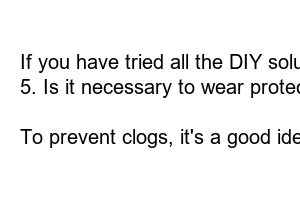변기 뚫는 방법
Do you find yourself faced with a *clogged toilet* at the most inconvenient times? Don’t panic! With a few simple steps, you can easily *unclog* it yourself without having to call a plumber. In this blog post, we will guide you through the process of unclogging a toilet effectively and efficiently.
**1. Assess the Situation**
Before you can begin to *unclog* your toilet, you need to first determine the severity of the blockage. Is the water slowly draining or completely stagnant? This will help you decide on the best course of action to take.
Is the blockage due to excess toilet paper, foreign objects like toys, or a build-up of waste and debris? Knowing the cause will make it easier to find a solution that works.
**2. Use a Plunger**
One of the most effective tools for *unclogging* a toilet is a plunger. Make sure to choose the right type of plunger – a flange or ball-shaped one works best for toilets. Place the plunger over the drain hole, ensuring a tight seal, then push and pull in a gentle but firm motion to create suction.
**3. Use a Toilet Auger**
If the plunger doesn’t work, consider using a toilet auger. This tool, also known as a plumbing snake, can help reach and break up stubborn clogs that the plunger can’t handle. Insert the auger into the drain hole and crank the handle to break up the blockage.
**4. Try a DIY Solution**
If you prefer a more natural approach, you can try using a mixture of hot water, dish soap, and baking soda to break up the clog. Simply pour the solution into the toilet bowl, let it sit for a few minutes, then flush to see if it clears the blockage.
**5. Call a Professional**
If all else fails, and you are still unable to *unclog* your toilet, it may be time to call a professional plumber. They have the necessary tools and expertise to handle even the most stubborn clogs and can help resolve the issue quickly and efficiently.
**6. Prevention is Key**
To avoid future clogs, it’s important to practice good toilet habits. Avoid flushing excessive amounts of toilet paper, sanitary products, wipes, or foreign objects down the toilet. Regular maintenance and use of a toilet drain cleaner can also help prevent clogs from forming.
In summary, unclogging a toilet can be a simple task with the right tools and know-how. By assessing the situation, using a plunger or toilet auger, trying a DIY solution, and practicing preventive measures, you can keep your toilet running smoothly.
**FAQs**
1. What should I do if the toilet is overflowing?
If the toilet is overflowing, turn off the water supply to the toilet by closing the shut-off valve located behind the bowl. This will prevent further flooding.
2. Can I use chemical drain cleaners to unclog a toilet?
It’s not recommended to use chemical drain cleaners in toilets, as they can damage the pipes and create more problems. Stick to more natural and gentle methods.
3. How do I prevent future clogs?
To prevent future clogs, avoid flushing anything other than toilet paper and waste down the toilet. Regular maintenance and use of a toilet drain cleaner can also help prevent clogs from forming.
4. How do I know if the clog is too severe for me to handle on my own?
If you have tried all the DIY solutions and still can’t *unclog* the toilet, it’s best to call a professional plumber for assistance. They have the tools and expertise to handle even the most stubborn blockages.
5. Is it necessary to wear protective gear when unclogging a toilet?
While it’s not required, wearing gloves can help protect your hands from coming into contact with any waste or debris. It’s always better to be safe than sorry.
6. How often should I clean my toilet to prevent clogs?
To prevent clogs, it’s a good idea to clean your toilet regularly. Using a toilet brush and cleaner at least once a week can help remove any build-up and prevent blockages from forming.

